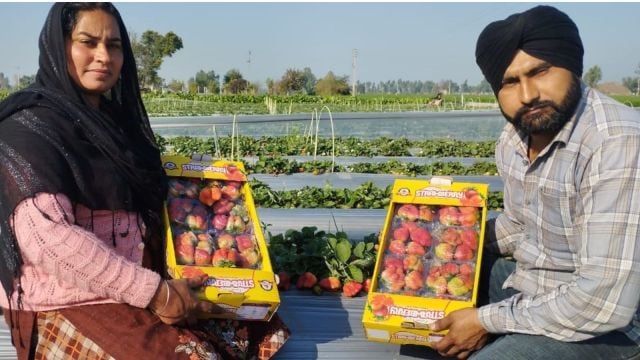Seeds of change: Transition to high-value crops like strawberry, dragon fruit helps Punjab farmers earn Rs 5-6 lakh per acre
The switch to high-value crops has provided economic stability to these farmers and their efforts highlight the untapped potential of horticulture in Punjab.
 Kulwinder Kaur motivated her husband Pardeep Singh to move beyond traditional wheat and paddy farming. (Express Photo)
Kulwinder Kaur motivated her husband Pardeep Singh to move beyond traditional wheat and paddy farming. (Express Photo)The lush fields of Jangal village in Pathankot are witnessing a quiet revolution in horticulture, led by a farmer who quit his high-paying urban job to return to his roots. Raman Salaria, a 40-year-old civil engineer, left a lucrative job with the Delhi Metro to cultivate a variety of horticultural crops.
It was seven years ago that Salaria took the bold decision to leave his Rs 1 lakh-plus monthly pay in Delhi. Motivated by the desire to stay closer to his parents and embrace a less stressful lifestyle, he shifted to his native place. Today, he manages a diversified 10-acre farm cultivating strawberries, dragon fruit, watermelon, turmeric and onion.
“My parents didn’t want to relocate, so I decided to return. Now, I earn much more than my previous job, and the stress is significantly less,” Salaria says, adding that he did not want to grow traditional crops like wheat and paddy as they were neither profitable nor sustainable. “Paddy is a big water guzzler,” he points out.
 Raman Salaria manages a diversified 10-acre farm cultivating strawberries, dragon fruit, watermelon, turmeric and onion. (Express Photo)
Raman Salaria manages a diversified 10-acre farm cultivating strawberries, dragon fruit, watermelon, turmeric and onion. (Express Photo)
Salaria’s foray into strawberry farming began five years ago with just half an acre. Today, he dedicates three acres to growing the Winter Dawn variety of the fruit, with 24,000 to 28,000 plants per acre sourced from Pune and Himachal Pradesh. “In Pune and Mangaluru, the mother plants are imported from the USA, Canada, and Italy. These are then multiplied and sold further as high-quality plants,” he explains, underlining the importance of sourcing quality plants to ensure higher profits.
“Sowing begins in November, but I start in September so that by November, the plants are already yielding,” Salaria says. “My main objective in sowing early is to enter the market before the regular strawberry season begins in January. By the time most farmers bring their produce to market, my crop is already being sold from November, fetching higher prices of Rs 400-500 per kg due to early availability.”
To ensure optimal growing conditions despite the heat in September, Salaria uses a micro-sprinkler system to maintain the right temperature for the plants. The fruiting season extends until April, with a yield of 90 quintals per acre. Prices initially peak at Rs 400-500 per kg but drop to Rs 150-200 per kg by April as market supply increases. He maximises profit by relying on drip irrigation and water-soluble NPK fertilisers, earning up to Rs 7 lakh per acre.
“The expenditure on strawberries, including plants, labour and nutrients, is around Rs 6-7 lakh per acre but the earnings are also substantial, at Rs 5-6 lakh per acre after meeting all expenses,” he says. Salaria also manages the packaging himself and traders visit his fields to procure the produce, eliminating the need for him to sell in markets.
Venturing into dragon fruit cultivation
In 2019, Salaria diversified into dragon fruit cultivation, dedicating 1.5 acres to the cactus-like crop. “Dragon fruit farming requires an initial investment of Rs 6 lakh per acre for reinforced cement concrete (RCC) pillars and plant setup, with annual maintenance costs of Rs 1 lakh,” he says. “On one acre, we have installed 500 pillars with four plants per pillar. Each pillar yields approximately 6 kg of fruit, translating to a total yield of 3,000 kg per acre. We sell it for Rs 350-400 per kg in retail markets and Rs 200-250 per kg wholesale. On average, dragon fruit generates Rs 7-8 lakh per acre annually.”
 In 2019, Raman Salaria diversified into dragon fruit cultivation (left), dedicating 1.5 acres to the cactus-like crop. (Express Photo)
In 2019, Raman Salaria diversified into dragon fruit cultivation (left), dedicating 1.5 acres to the cactus-like crop. (Express Photo)
Salaria grows both white and red varieties of dragon fruit and has had no issues with marketing due to consistent demand. “The plants are sourced from South India and are planted between February and March. They begin fruiting after 1.5 years, but commercial viability is achieved after three years. The plants don’t need to be replaced, they just require proper care and maintenance,” he adds.
To optimise land use, Salaria intercrops onions in the dragon fruit fields, utilising the 10-11 feet space between rows. In summer, he cultivates red and yellow watermelons, while turmeric is grown on another portion of his land.
“This is a highly profitable business but it requires hard work and attention to detail unlike traditional crops like wheat and paddy which demand less effort but yield lower returns,” Salaria notes.
A woman farmer’s vision to diversify
A few years ago, Kulwinder Kaur, who hails from Faridkot district’s Manisinghwala village, motivated her husband Pardeep Singh to move beyond traditional wheat and paddy farming. Singh then visited strawberry farmers, even some outside Punjab. A couple of years back, the couple ventured into strawberry farming, investing Rs 7 lakh on a one-acre plot, and eventually extended the cultivated area by another half acre. Besides, they have dedicated another half an acre to an orchard that grows a variety of fruits. Meanwhile, on the remaining 13 acres of their land the two are still cultivating paddy and wheat, which they plan to reduce gradually.
 “Despite the high initial investment, we earned Rs 6 lakh from one acre of strawberries — we could never achieve this with wheat and paddy,” says Kulwinder Kaur. (Express Photo)
“Despite the high initial investment, we earned Rs 6 lakh from one acre of strawberries — we could never achieve this with wheat and paddy,” says Kulwinder Kaur. (Express Photo)
“Despite the high initial investment, we earned Rs 6 lakh from one acre of strawberries — we could never achieve this with wheat and paddy,” Kaur says.
Singh says they also cultivate onion and green chillies alongside the strawberry. “With this, we are taking the income of three acres from the one-acre plot,” he adds. Kaur also emphasises the labour-intensive nature of the crop, explaining, “We have to monitor every plant carefully and handle the packaging ourselves to ensure good returns.”
They got the idea for strawberry farming from YouTube but the couple believes that government support in providing high-quality plants locally would reduce the need to procure them from South India. “We are planning to set up a poly house on one acre now and also intend to start papaya cultivation soon as we can never earn big from wheat and paddy,” says Singh, mentioning that their 1.5-acre strawberry field also provides employment to five women in the village.
Starting small, dreaming big
An accountant-turned-farmer, Paramvir Singh, is proving that small beginnings can lead to big successes. Hailing from Amrala village in Fatehgarh Sahib district, Paramvir and his father Jasvir Singh started horticulture on a one-acre plot in 2023, cultivating yellow dragon fruit, kinnow, mausambi, papaya and guava.
Paramvir’s initial success with 2,000 dragon fruit plants inspired him to expand his operations, with plans to add 1,500 more plants in February. “I started with plants sourced from Karnataka but now I grow my own and sell them to farmers in Rajasthan, Haryana and Uttar Pradesh,” he shares.
 Jasvir Singh in his dragon fruit field. (Express Photo)
Jasvir Singh in his dragon fruit field. (Express Photo)
Though full commercial profitability is expected only next year, Paramvir has already earned over Rs 1 lakh from his first dragon fruit yield even though less than half of the plants bore fruit.
While other farmers grow seasonal vegetables like onion, chilli and garlic as intercrops, Paramvir uses the trellis method (growing on raised structures) to maximise his dragon fruit yield.
Such out-of-the-box efforts by farmers like Salaria, the Singhs and Paramvir not only provide economic stability to their families but also inspire their neighbours to transition from traditional crops to high-value horticulture. Their stories highlight the untapped potential of horticulture in Punjab and the rewards of taking calculated risks to follow one’s passion.












